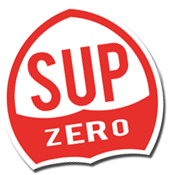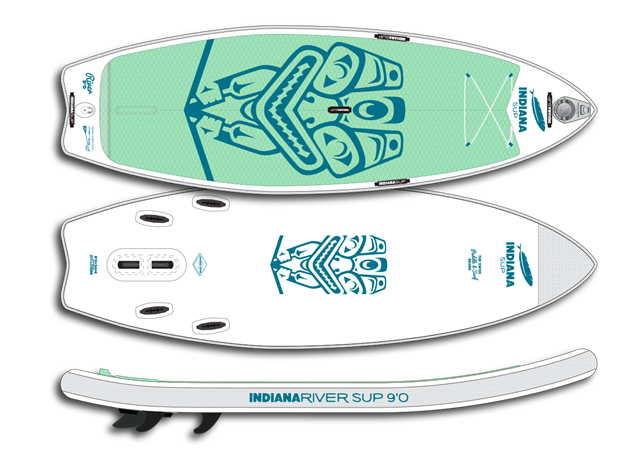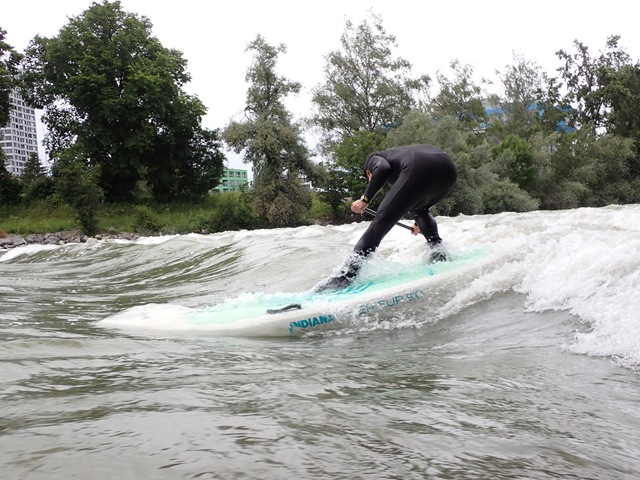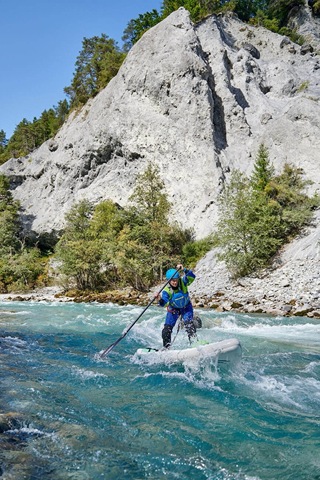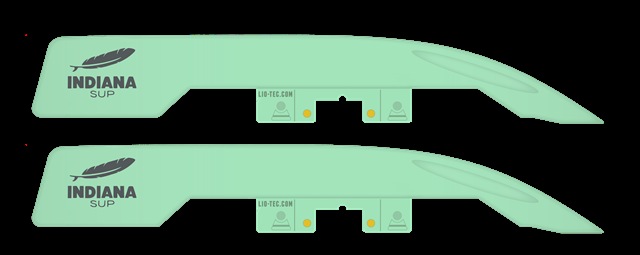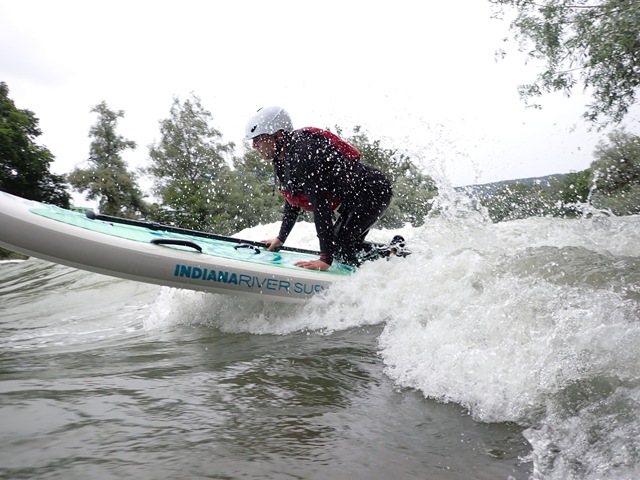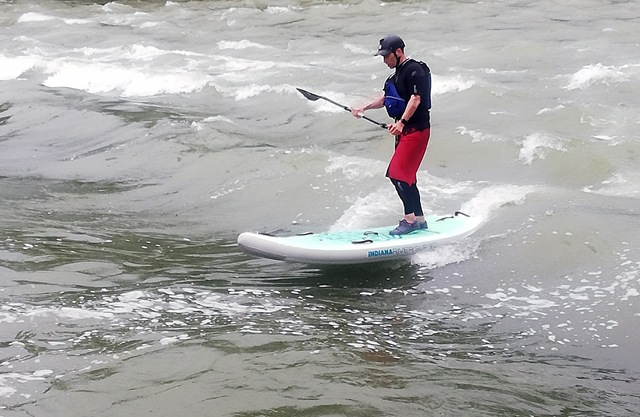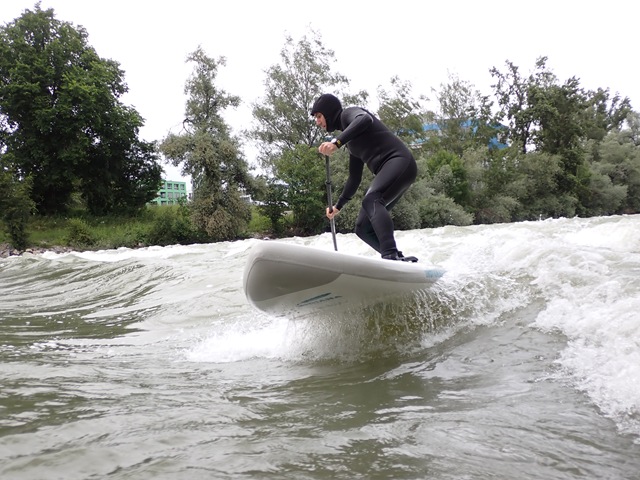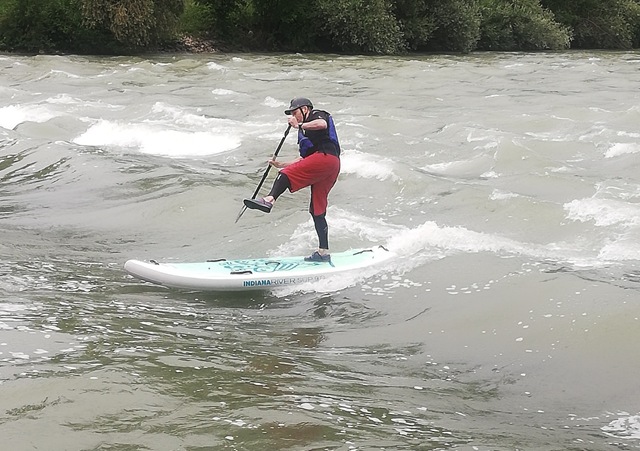[please login to make this ad block disappear]
Articles
Inedpendent Review: Indiana River 9’0
This is an independent SUPzero review of the Indiana River 9’0 inflatable SUP board, which was introduced in 2021, along with a larger brother, the River 10’2. Both boards were designed by my fellow Swiss Whitewater SUP instructor Rene Lehmann. 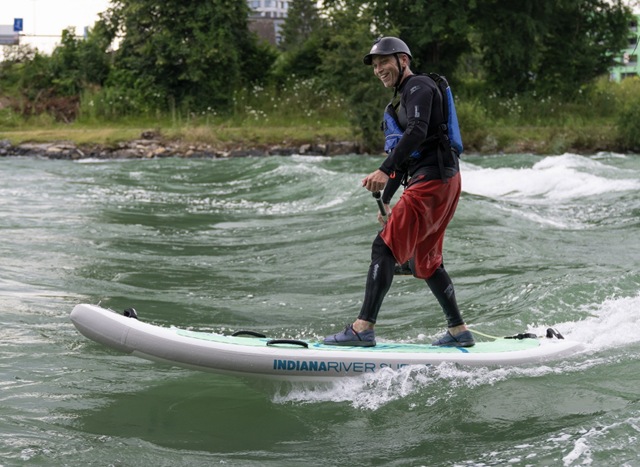
About Indiana
Indiana is a Swiss brand that started making skateboards in 1989 and diversified into SUP in 2010. In the early SUP years Indiana concentrated on touring, racing and surf, but lately they became very active in foil and wing surfing, and this year they entered the river SUP market.
About the Board
This is the official Indiana text about the board:
“The smaller of the two River SUPs is the ideal companion for wild waters adventures. The inflatable 9’0 River SUP was developed in cooperation with wild water expert René Lehmann. The shape impresses with a functional outline, where the widest point of the SUP is behind the middle. This special volume distribution, in combination with a progressive rocker line on the front and the rear end makes the board very agile and allows precise steering. Also, thanks to the mentioned volume distribution, the board is very stable and keeps its track when passing through rapids. With an additional PVC strengthening on the rear end and the hull of the nose, the construction with Woven Real Double Layer (2x0.7mm) leaves no room for desires when it comes to stiffness, durability and weight.”
About the Reviewer
I took up whitewater kayaking in 1995, switched to whitewater SUP in 2010, and became an ACA certified Whitewater SUP Instructor in 2013. These are my paddling preferences (for both kayak and SUP):
- I like rivers.
- I like playful paddling.
- I like medium size river waves.
- I prefer technique perfection over adrenaline: I paddle up to WW level III or IV, with level II to III giving me the most satisfaction.
As a disclaimer: I personally know both the Indiana CEO and the board’s designer, but as always, I will make sure this review is independent, and critical where appropriate. Having said that, it turned out I mostly liked this board.
Review Process
I paddled the board myself on easy whitewater (0-I-II) and surfed it on the fairly small (2 ft) and slow Fahrweid wave on the Limmat in Switzerland. I also gave the board to beginners during classes and surf sessions and asked for their feedback.
Shape
The River 9’0 obviously shares some design details with other whitewater boards. It is short and wide (34”), with quite a bit of rocker. The difference to other typical 6”-thick whitewater boards is in the details. The River 9’0 has progressive rocker, whereas other whitewater boards often have more continuous rocker. Progressive means that the rocker is mostly in the nose and tail, and the center part is almost flat. This has the advantage that the board is a bit faster, and your feet stay more out of the water. As a trade-off, it gives the board a bit less secondary stability, makes it a bit harder to turn, and makes the nose dive a bit more (pearling). As for pearling during surfing, it didn’t happen very often, but when it did, the board was stable and forgiving enough to just wait and shift your weight backward, and the board would pop up again after a couple of seconds (see the Youtube video below).
https://www.youtube.com/watch?v=pg3oEN8mb8g
The widest point of the board is roughly 1 foot behind the carrying handle, which gives the board extra stability. Moving the widest point further back would make it even more stable, but the resulting wedge shape would also make it slower. The exact location of the widest point is always a topic for discussion and taste, but I think Rene found a great compromise on the River 9’0.
All in all, the shapes of the River 9’0 make this a stable and forgiving river board that is still fairly fast. I only tested it on easy whitewater, but I would feel totally confident to use it for trips on WW III-IV, especially on technical runs. On big water runs (or if I would weigh over 90 kg) I might prefer the larger version, although 10’2 is very long for a river board in my humble opinion.
Materials
The drop stitch material is woven (real double layer woven, 2x0.7mm), which means that the threads inside the board cross at a small angle. As a result, the board is stiffer and weighs less. It is noticeably lighter to carry than other similar boards I often use. It does mean that the board feels a bit less robust, but I have yet to break a board on rocks anyway – my boards only break due to sunshine and glue failures. Which brings me to the next point, the colors.
The Indiana River boards use bright colors only, for the main drop stitch material, the rails and the deck pad. This gives it a surf touch that I personally like, but tastes may vary. It also has the advantage that the board doesn’t heat up as much in the sun. I lost four boards during the past ten years, and all of them broke due to melting glue, typically during lunch breaks, when the sun is high in the sky and shade is hard to find.
The finishing of the board is great – it feels like quality control is taken seriously at Indiana. I found no sloppy details like excessive glue, loose ends, or crooked parts.
Features
The deck pad is the diamond cut type, which makes it extra grippy, and it covers most of the deck. I love decks covered with pad as they allow me to walk around on the board. Unfortunately, the very front of the board is not padded, probably to leave room for the nice logo, but that is exactly the area I have to stand on for some playing and tricks, so I may add padding there myself later on.
The bungy deck line has only four attachment loops, and they are placed quite close together, so there is not much storage space for overnighters or even carrying the backpack and pump. Of course, this is also related to the board being just 9’ long, so there isn’t that much space available anyway, and I think the 10’2 version has six attachment points. The bungy line has an integrated rope clam, which makes it really easy to adjust the line or even remove it for park-n-play sessions.
The River 9’0 has 4 nicely padded grab handles, which is good practice for a whitewater board.
The board has an integrated camera mount, which is a standard 1/4-20 UNC thread (6mm). For safety reasons, this is a female connection point, so be aware that you may need a male-male connector for your camera. I am not quite sure why the mount is on the tail of the board instead of the nose. I personally like frontal photos of myself having fun instead of from my behind.
There is a D-ring on the nose, which is handy for securing valuable items or for towing the board, although for towing purposes it would be slightly better to have that D-ring on the hull instead of the deck. That would also create space for a nose camera mount.
The center fin is a US-box system, which I am personally not a fan of for river boards, mostly because it is more work to remove or attach the fin during a trip and the small parts are prone to getting lost, but also because replacement fins are more expensive than with a sliding fin system. A sliding fin box would however be difficult to position in exactly this location, as this is where the tail rocker starts. That rocker would also have been a problem for a standard US-box, but Indiana chose to use the innovative split US-box, due to which the rocker doesn’t put stress on the box, even with the fin mounted. Another advantage is that it is easier to roll up the board than with one long fin box, although in this case the rear side fins are covering that gap area, so it’s still not optimal for rolling up the board. One small improvement would be to move the tail half of the box a bit further backward. Not only would this put a bit less stress on the side fin boxes when the board is rolled up, but it would also create a bit more space between the two halves of the US-box, which would make it easier to position the screw plate when screwing in the fin.
The side fins use a click fin system, in which many fins will fit. Indiana even offers their own extra shallow river fins for rocky whitewater. The toe of the side fins (angle) is a bit too much in my opinion. The angle creates a bit more drag, which makes the board a bit slower than necessary. The advantage of the toe is that it steers the board when you put weight on one side, so that’s especially handy when surfing and on eddy lines. It’s a trade-off against a little bit of speed, most people wouldn’t notice the difference, and in the end, it is mostly a matter of taste.
The backpack comes with wheels, and also with a fairly unique function: a paddle can be attached as a handle to drag it around like a little cart.
Performance
The text above is laced with my own impressions, so let me use this chapter just to sum up the feedback I got from beginners.
People in my SUP classes loved this board, both for flatwater playing, river running and river surfing. They found it very friendly and forgiving, and easy to carry (weight is often an issue for beginners, who are not used to carrying boards).
Price
For a well-designed and good quality river board by a top Swiss brand, the price is remarkably competitive: CHF 1099 / EUR 999 (which is about USD 1200 at the current conversion rate of August 2021). The larger River 10’2 costs 5% more.
Conclusion
This board is slowly becoming my own favorite for general river running. I own some boards that surf better, some that are easier for playing, and some that are better for big water, but I have no other board that does it all so well.
To sum it up, the Indiana River 9’0 is a well-designed, versatile, high quality board at a very reasonable price.
Photos
Some additional random photos.
